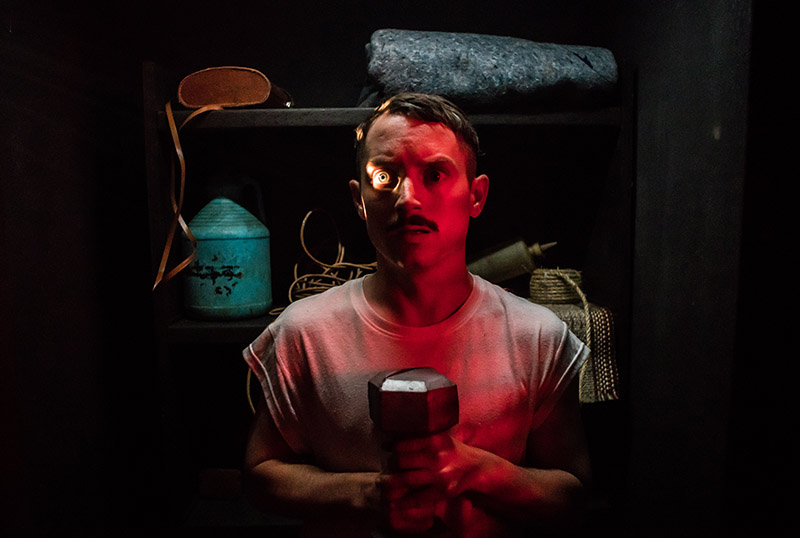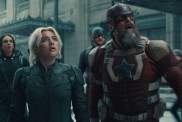In the years since The Lord of the Rings, Elijah Wood has made a real name for himself in the horror genre as both a star and producer and the time has come for another acclaimed and macabre effort in the form of the horror-comedy Come to Daddy. ComingSoon.net got the chance to sit with the star and director Ant Timpson to discuss bringing the story to life and some of the more bizarre turns the story and characters take.
RELATED: Elijah Wood Has a Macabre Family Reunion in Come to Daddy Trailer
Norval Greenwood (Wood), a privileged man-child, arrives at the beautiful and remote coastal cabin of his estranged father. He quickly discovers that not only is dad a jerk, but he also has a shady past that is rushing to catch up with both of them. Now, hundreds of miles from his cushy comfort zone, Norval must battle with demons, both real and perceived, in order to reconnect with a father he barely knows.
The film is written by Toby Harvard (The Greasy Strangler), based on a story idea from Ant Timpson (The ABCs of Death), and is directed by Timpson. In addition to Wood, the film features a cast that includes Stephen McHattie (Watchmen), Garfield Wilson (The Man in the High Castle), Martin Donovan (Tenet), Michael Smiley (The World’s End) and Simon Chin (Killing Eve).
Harvard is producing the film alongside Laura Tunstall, Emma Slade, Mette-Marie Kongsved, Katie Holly and Daniel Bekerman, with Lia Buman, Tim Headington, and Timpson set as executive producer.
The horror-comedy is set to hit select theaters and video on demand on February 7.
In venturing to meet his estranged father, Wood’s Norval must travel to a remote cabin sitting on a rockside cliff, à la less-rich Tony Stark, which Timpson described as spawning from the desire to have the house itself “be a major character in the film” and from their scouting trips in Canada.
“Because we were going to be at the house most of the movie, it needed to be something interesting cinematically and it had to offer a lot of things that were in the script,” Timpson said. “We spent a long time, two scouting trips really, all over this place that we shot called Vancouver Island, which is a huge geographical area to cover. There were a lot of houses that might’ve worked, but they wouldn’t have been the same film, it would’ve lost a lot. The minute I saw the place, I was like ‘That’s heaven, we have to shoot in this house.’ It just offered everything in terms of how it sets the character up in a really sort of isolated terrain and it does half the job for us straight away, it helped us a lot.”
“It’s a really iconic looking home,” Wood agreed. “It does sort of set the tone of the scene and it was very much of what [Ant] sort of described. We really lucked out because there were other homes too in consideration.”
“It’s hard to find something on rocks, built on rugged terrain, especially for a place that has extreme weather,” Timpson continued. “We adapted the script to fit the location as well. So Toby, the writer, I just kept sending back images and drawing on these Google photos of ‘This is where it is and let’s try and structure the logistics around it.'”
“Interesting story, the back-story of the home is that it was actually built by a father and son,” Wood noted. “Kind of incredible, it has this really kind of apropos back-story.”
“Yeah, a much nicer story,” Timpson says as he and Wood both laugh.
Timpson spawned the concept from the story from his personal experience of having his own father pass away in front of him, but he credits much of the film’s twists and character’s bizarre personalities to the film’s writer Toby Harvard, with who he previously worked with on The Greasy Strangler.
“I gave him the skeleton idea of what the inspiration was, and then he took it and ran like a maniac,” Timpson said. “Everything about the creation of the Norval character, it’s not autobiographical in any way. It’s a fully-fledged creative idea from Toby himself, and Elijah brought everything to it, brings him to life. I wish I could say that I completely created Norval, but that’s what writers are for.”
“Norval wasn’t inspired by anyone specifically, I didn’t necessarily bring anything to the table in regards to a person I know,” Wood said. “Toby wrote him pretty vibrantly and there’s a lot there for me to work with. When I first got the script, it was initially sent with an image of Skrillex and was like, ‘He kind of looks like this.’ Skrillex isn’t that extreme compared to the people that he then sent when we got into production. Once I was ensnared and we were making the movie, he was like ‘How about these people?'”
“Once you said yes, his confidence level went up,” Timpson laughed. “It was like, ‘I’m going to start throwing everything I can at the guy.’ We went all over the show and then honed it down from soccer stars to weird Eurovision contest people. We wanted to distract from your blue eyes, and you keep going back up to your eyes, but the mode just brings you down, so I thought that was really compelling. It was a collaboration between Elijah, Toby and I, I wanted him to look so extreme and that the first time you see him feel like an alien in a foreign landscape. Elijah then rightly said, ‘We can’t be too cartoonish.”
“Yeah we have to keep him human,” Elijah chuckled. “He has to feel like a person that exists in the world somewhere.”
RELATED: CS Interview: Lynne Sachs on Personal Journey in Film About a Father Who
One of the many things that a film can celebrate is accidental magic, including instances where an unplanned action can turn into a compelling bit, even if it is something as brief as throwing “The Celestine Prophecy” aside only for it to land elegantly against a nearby wall in the background.
“Our intention was never to have it land in that way, it just happened, it’s supposed to be tossed off-screen, right,” Wood asks Timpson.
“Well, the first time you did, I think you threw it right over the railing,” Timpson laughs. “Then the second take, I think that happened.”
“I wasn’t making any attempt to land it perfectly,” Wood said.
“Then I thought, oh that’s such a Celestine thing,” Timpson joked. “We shot like Kubrick, we did 10,000 takes, we had to get it. It’s actually a CG shot, there are puppeteers above it. It was happenstance, they happened throughout the whole production, beautiful things that you can’t control.”
With the many dangers Wood’s Norval has to encounter throughout the film, the two mentioned that the only challenge they really found while shooting was time, but that they thrived on the pressure that came from the expedited timetable.
“You want a film experience to be challenging, you don’t want it to be too easy,” Wood said. “A challenge means you’re being creatively inspired. I think that’s an important energy to have creatively, but this was a very enjoyable film to make. We had a blast, it was a really small, intimate crew, the crew was really incredible. It was a mix of Canadians and Kiwis, a few Kiwis came out.”
“We were in the house with the beautiful sun all the time,” Timpson marveled. “It was a dream. Originally it was going to be a winter shoot, so it could be in completely brutal weather because there it gets windy as hell, cold, snowy, raging seas, which would’ve been a very sort of different film, and some ways, more traditional than kind of what is expected. You kind of expect that dark and stormy, we’ve seen it 100 million times, so it’s kind of nice that we got bumped and things changed.
“I think for me specifically, what Norval goes through, especially in solitude, is intense emotionally and it’s a bit of a rollercoaster,” Wood continued. “You get a lot of different colors from him in terms of an emotional experience in a relatively short amount of time. So I felt a great deal of pressure to deliver on that, and make that authentic to that experience, and also to honor Ant’s experience. So that for me was my biggest challenge because where it goes in the second and third act is so fun, that stuff’s fun. That’s the kind of mad, thriller aspect of the film that’s really fun to play and not necessarily scare for me. The scary stuff are the real moments, the honest emotion of what the character goes through, and not having a lot of time to deliver on that. We didn’t have a rehearsal period, and we didn’t have a lot of time, because we were cramming quite a lot into our days. There’s only so many takes, so just feeling that pressure and wanting to make sure that everything is delivering in the most authentic way possible.”
“What’s super impressive about Elijah is that because we’re shooting in one location with super limited locations, and somewhat out of sequence, there’s so much that looks exactly the same in the film, but at different time periods in the film that it got kind of this weird miasma of ‘What the hell?'” Timpson said. “It looks the freaking same, what’s going to feel different? But you were really on, exactly knew the beats where you had to be wherever we were.”
RELATED: CS Interview: Richard Stanley on His Passion Project Color Out of Space
The duo also credit script supervisor Monique Knight for helping keep things on track, who Timpson called “amazing,” and Wood stating “she really helped all of us, keeping us straight in terms of where we were” in the script.
In his transition to working in the horror genre, Wood co-founded the production company SpectreVision with Daniel Noah and Josh C. Waller, which has produced a number of acclaimed projects, including the recently released Lovecraft adaptation Color Out of Space starring Nicolas Cage (Mandy) and written and directed by Richard Stanley. With the adaptation proving to be a success and Stanley looking to develop a Lovecraft trilogy with SpectreVision, Wood confirmed that Stanley is working on Dunwich Horror as the next installment while having to “keep mum” on what the third installment could be.
“I don’t know if Call of Cthulhu has entirely been decided, or maybe it has been and I’m just not aware of it, but Dunwich is definitely the next thing,” Wood said.










